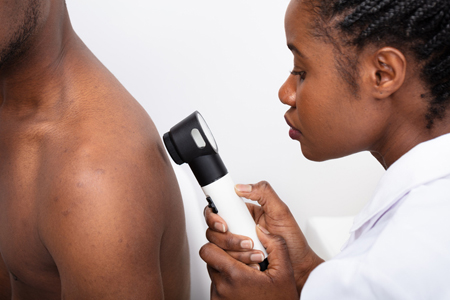Fitness
4 Tips For Diverse Recruiting In Dermatologic Clinical Trials

By Alain Michon, MD, medical director, Project Skin MD Ottawa
For far too long, dermatologic clinical trials have excluded marginalized populations. As a result, the skin health disparities within these communities have been exacerbated, and the lack of research knowledge has led to inadequate treatment options. Other results include issues such as late diagnoses, misdiagnoses, and additional health complications for these underserved populations.
Diversity in participant recruitment is essential to improve the success and impact of dermatologic clinical trials. Diverse representation ensures that research findings are applicable and beneficial to a broader population, reflecting real-world demographics and enhancing the generalizability of study results. Inclusivity in clinical trials is also essential for addressing health disparities among various demographic groups. By actively recruiting individuals from diverse backgrounds, including those from racial and ethnic minorities, different socioeconomic statuses, and varying geographic regions, researchers can better understand how dermatologic conditions manifest within these populations—and how to treat these experiences.
However, barriers to access disproportionately affect minority and marginalized communities, hindering their participation. Addressing these challenges requires a multifaceted approach that acknowledges the root causes of inequalities and implements practical, ethical strategies for more representation in these trials.
What Are Dermatological Health Disparities?
Dermatological health disparities refer to differences in the prevalence, presentation, treatment outcomes, and overall burden of skin conditions among various demographic groups. These differences often persist across racial and ethnic lines, socioeconomic statuses, geographic regions, and other sociocultural factors.
For example, skin cancer morbidity and mortality are higher in Black and Hispanic people and those of lower socioeconomic status. Additionally, minority populations, like Black and Hispanic patients, are less likely to receive outpatient dermatological care than their white counterparts.
So, why do these disparities in skin conditions and dermatological care exist? There are several key contributing factors, including:
- Limited access to dermatologic care due to geographic barriers, financial constraints, lack of insurance coverage, and transportation issues;
- A lack of sufficient awareness and understanding of dermatologic conditions that can lead to delayed recognition of symptoms, postponement of seeking medical attention, and reliance on non-medical remedies or self-diagnosis;
- Misinformation, in the form of “half-truths,” information from uncredible sources, and information that does not apply to their skin type, on social media
- Stigma surrounding certain skin conditions, cultural misconceptions, and language barriers;
- Delayed diagnosis and misdiagnosis;
- Underrepresentation in dermatologic clinical trials;
- Disproportionate exposure to environmental hazards that increase the risk of skin conditions, such as sun exposure-related disorders;
- Genetic predispositions that affect susceptibility, severity, and treatment response; and
- Assessment tools and rating scales that may not adequately capture the nuances of disease presentation and severity in diverse skin types.
To help counteract these disparities, our center is part of a multicenter clinical trial on the efficacy and patient-reported outcome of cosmetic onabotulinumtoxinA for the treatment of upper facial wrinkles. In the past, studies in this area were mainly performed on white women. For this trial, we are mandated that a portion of our subjects be men and darker-skin-type patients, as they were unrepresented in previous studies.
Why Don’t More Underserved Populations Participate In Clinical Trials?
Even with mandates to include minority populations in present studies, several barriers hinder the participation of underserved populations in dermatological clinical trials, increasing disparities in research representation and treatment outcomes. These barriers stem from various factors affecting both participants and researchers:
- Lack of Awareness and Trust: Underserved communities may have limited awareness of clinical trials and mistrust towards medical research due to historical exploitation, unethical practices, and systemic discrimination in healthcare. This lack of understanding and trust can lead to skepticism about research motives and reluctance to participate.
- Financial Constraints: Participation in clinical trials often involves additional costs such as transportation, childcare, and time off work, posing significant financial burdens for individuals from low-income backgrounds. Lack of reimbursement for these expenses may deter participation, particularly among poor populations.
- Language and Cultural Barriers: Language barriers and cultural differences in healthcare beliefs and practices can impede effective communication between researchers and potential participants. Inadequate linguistic and culturally sensitive recruitment materials, informed consent forms, and study protocols may further alienate diverse communities and hinder their willingness to participate.
- Geographic Accessibility: Limited availability of clinical trial sites in underserved areas and transportation challenges prevent individuals from accessing research opportunities. The concentration of research institutions in urban centers may disproportionately exclude rural and remote populations from participating in clinical trials.
- Institutional and Systemic Biases: Institutional biases and systemic inequities within the research enterprise perpetuate disparities in participant recruitment. Implicit biases among researchers and healthcare providers, lack of diversity in research teams, and institutional barriers to inclusive recruitment practices contribute to the underrepresentation of diverse populations in clinical trials.
Addressing these barriers requires collaborative efforts to enhance community engagement and trust and promote more inclusive and representative clinical research practices.
Tips For Recruiting Diverse Participants
Researchers must adopt new ethical recruitment practices to help remove barriers to participation in dermatologic clinical trials:
1. Culturally Tailored Informed Consent Process
Adapt the informed consent process to accommodate the cultural preferences and literacy levels of diverse participants. Explain study procedures, risks, benefits, and rights clearly. Communicate using plain language, visual aids, and the participant’s native language. Offer opportunities for participants to ask questions, seek clarification, and discuss concerns with research staff or trusted community members to ensure informed decision-making and voluntary participation.
2. Community Engagement And Outreach Programs
Since one of the most significant barriers to participation involves a lack of trust and knowledge about these trials, engaging directly with the communities through outreach programs is essential.
Engage with community organizations, religious institutions, and local leaders to build trust and rapport within underserved communities. First and foremost, establishing partnerships allows researchers to understand these communities and better gauge barriers and challenges. Engagement and outreach also enable researchers to provide information about clinical trials, address concerns, and tailor recruitment strategies to meet the needs and preferences of diverse populations.
As part of these engagement efforts, also consider creating recruitment materials that are culturally sensitive and linguistically appropriate, as described above.
Being based in Canada, we notice historical challenges around engaging Indigenous communities specifically, as systemic issues have isolated these communities in all aspects of healthcare. Here, it becomes especially important to decipher who the gatekeepers of the communities are and fully understand their concerns before presenting the trial’s needs. Understanding the longstanding history between Indigenous groups in Canada, the government, and healthcare institutions helps to inform the community engagement approach and allows outreach programs to resonate more effectively with potential recruits.
3. Flexible Study Design And Logistics
To combat worries about financial and time constraints, design studies with flexible protocols and logistical arrangements to accommodate the needs of all participants. Offer flexible appointment scheduling, transportation assistance, childcare services, and remote participation options to reduce barriers related to transportation, caregiving responsibilities, and work obligations, thereby facilitating participation among underserved populations.
4. A Diverse Research Team
A research team that reflects the diversity of the target population promotes better-informed trial protocols. Aside from researchers who share the recruited participants’ cultural backgrounds and lived experiences, you can also actively involve community members, patient advocates, and representatives to help guide the development and implementation of the study.
Overall, their insights, perspectives, and lived experiences can inform culturally sensitive recruitment strategies, enhance the study’s relevance, reliability, and ethics, and address potential barriers to participation.
Next Steps For Diverse Dermatologic Clinical Trials
Diverse recruitment in dermatologic clinical trials is imperative for addressing health disparities and advancing equitable care. By understanding the barriers underserved populations face and implementing practical strategies for inclusive recruitment, researchers can improve the representation and relevance of their studies.
Achieving true diversity requires ongoing commitment and collaboration with communities. When it comes to improving dermatologic clinical trials, the step in the right direction will involve educating researchers on diversity and systemic barriers, developing new ethical frameworks for fostering trust, and prioritizing the voices of marginalized populations.
About the Author
 Dr. Alain Michon is the medical director of Project Skin MD Ottawa, as well as a speaker and educator. He is board-certified by the American Academy of Aesthetic Medicine and is passionate about continuing education to offer his patients the best techniques, treatments, and technologies available. Dr. Michon has completed a Post Graduate Diploma in Clinical Dermatology and a Master of Science in Aesthetic Medicine from the Queen Mary University of London, UK, graduating with distinction from both programs. He also earned a Master of Science in Skin Aging and Aesthetic Medicine (with mention) from the University of Manchester, UK.
Dr. Alain Michon is the medical director of Project Skin MD Ottawa, as well as a speaker and educator. He is board-certified by the American Academy of Aesthetic Medicine and is passionate about continuing education to offer his patients the best techniques, treatments, and technologies available. Dr. Michon has completed a Post Graduate Diploma in Clinical Dermatology and a Master of Science in Aesthetic Medicine from the Queen Mary University of London, UK, graduating with distinction from both programs. He also earned a Master of Science in Skin Aging and Aesthetic Medicine (with mention) from the University of Manchester, UK.










